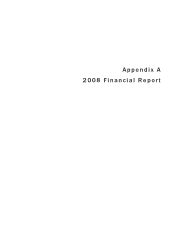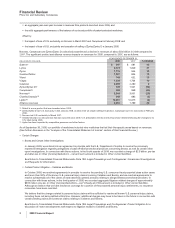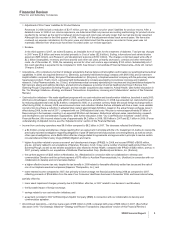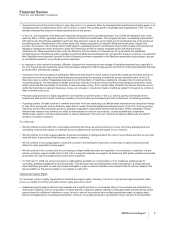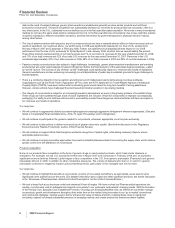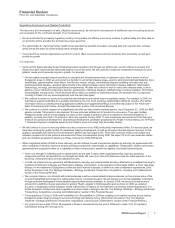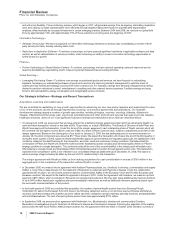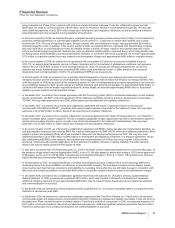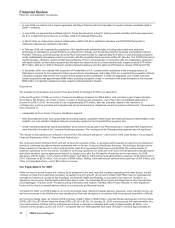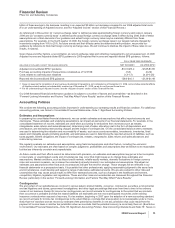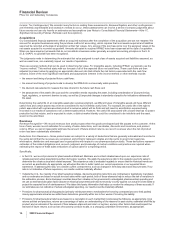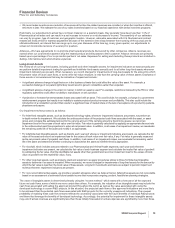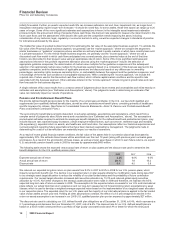Pfizer 2008 Annual Report Download - page 8
Download and view the complete annual report
Please find page 8 of the 2008 Pfizer annual report below. You can navigate through the pages in the report by either clicking on the pages listed below, or by using the keyword search tool below to find specific information within the annual report.
Financial Review
Pfizer Inc and Subsidiary Companies
date as the result of a legal challenge, generic pharmaceutical manufacturers generally produce similar products and sell those
products for a lower price. This price competition can substantially decrease our revenues for products that lose exclusivity, often in a
very short period. In the U.S., substantial revenue declines occur in the first year after patent expiration. Revenues in many international
markets do not have the same sharp decline compared to the U.S. in the first year after loss of exclusivity, due to less restrictive policies
on generic substitution, different competitive dynamics, and less intervention by government/payers in physician decision-making,
among other factors.
•The loss of patent protection with respect to any of our major products can have a material adverse effect on future revenues and our
results of operations. As mentioned above, our performance in 2008 was significantly impacted by our loss of U.S. exclusivity for
Norvasc in March 2007 and Camptosar in February 2008. Further, we experienced a substantial adverse impact on our 2008
performance from the loss of U.S. exclusivity for Zyrtec/Zyrtec D in late January 2008, at which time we ceased selling this product.
These three products represented 6% of our total revenues and 1% of our total U.S. revenues for the year ended December 31, 2008,
and 11% of our total revenues and 12% of our total U.S. revenues for the year ended December 31, 2007. Revenues in the U.S.
contributed approximately 42% of our total revenues in 2008, 48% of our total revenues in 2007 and 53% of our total revenues in 2006.
•Patents covering our products are also subject to legal challenges. Increasingly, generic pharmaceutical manufacturers are launching
products that are under legal challenge for patent infringement before the final resolution of the associated legal proceedings—called
an “at-risk” launch. The success of any of these “at-risk” challenges could significantly impact our revenues and results of operations.
Generic manufacturers are also advancing increasingly novel interpretations of patent law to establish grounds for legal challenges to
branded patents.
•There is a continuing disparity in the recognition and enforcement of intellectual property rights among countries worldwide.
Organizations such as the World Trade Organization (WTO), under the WTO Agreement on Trade-Related Aspects of Intellectual
Property Rights (TRIPS), have been instrumental in educating governments about the long-term benefits of strong patent laws.
However, certain activists have challenged the pharmaceutical industry’s position in developing markets.
•The integrity of our products is subject to an increasingly predatory atmosphere, as seen in the growing problem of counterfeit drugs.
These drugs can harm patients through a lack of active ingredients, the inclusion of harmful components or improper accompanying
packaging. Our ability to work with law enforcement to successfully counter these dangerous criminal activities will have an impact on
our revenues and results of operations.
Our response:
•We will continue to aggressively defend our patent rights against increasingly aggressive infringement whenever appropriate. (See also
Notes to Consolidated Financial Statements—Note 19. Legal Proceedings and Contingencies).
•We will continue to participate in the generics market for our products, whenever appropriate, once they lose exclusivity.
•We will continue to take actions to deliver more products of greater value more quickly. (See further discussion in the “Regulatory
Environment and Pipeline Productivity” section of this Financial Review.)
•We will continue to support efforts that strengthen worldwide recognition of patent rights, while taking necessary steps to ensure
appropriate patient access.
•We will continue to employ innovative approaches to prevent counterfeit pharmaceuticals from entering the supply chain and to achieve
greater control over the distribution of our products.
Product Competition
Some of our products face competition in the form of generic drugs or new branded products, which treat similar diseases or
indications. For example, we lost U.S. exclusivity for Norvasc in March 2007 and Camptosar in February 2008 and, as expected,
significant revenue declines followed. Lipitor began to face competition in the U.S. from generic pravastatin (Pravachol) and generic
simvastatin (Zocor) in 2006, in addition to other competitive pressures. The volume of patients who start on or switch to generic
simvastatin continues to negatively impact Lipitor prescribing trends, particularly in the managed-care environment.
Our response:
•We will continue to highlight the benefits of our products, in terms of cost, safety and efficacy, as appropriate, as we seek to serve
significantly more patients around the world. (For detailed information about Lipitor and other significant products, see further discussion
in the “Revenues—Pharmaceutical—Selected Product Descriptions” section of this Financial Review.)
•We took a broad look at our business model and examined it from all angles. We have evolved our Pharmaceutical operations into
smaller, more focused units to anticipate and respond more quickly to our customers’ and patients’ changing needs. With the formation
of the Primary Care, Specialty Care, Established Products, Oncology and Emerging Markets units, we believe we can better manage
our products’ growth and development throughout their entire time on the market; bring innovation to our “go to market” promotional
and commercial strategies; develop ways to further enhance the value of mature products, including those close to losing their
exclusivity; expand our already substantial presence in emerging markets, and create product-line extensions where feasible.
6 2008 Financial Report

